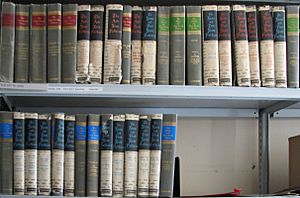Patristics facts for kids
Patristics (say: puh-TRIS-tiks) is the study of important early Christian writers. These writers are often called the Church Fathers. The words "patristics" and "patrology" come from Latin and Greek words meaning "father."
The time when these Church Fathers lived and wrote is known as the Patristic era. This period generally started around the year 100 AD, after the New Testament times. It usually ended either in 451 AD (the year of the Council of Chalcedon) or in 787 AD (the year of the Second Council of Nicaea).
Contents
Who Were the Church Fathers?
The Church Fathers were early Christian leaders and thinkers. They helped shape what Christianity became. They wrote many important texts about faith and the Church.
Different Groups of Church Fathers
These early writers are often divided into two main groups based on when they lived:
- Ante-Nicene Fathers: These are the writers who lived and wrote before the First Council of Nicaea in 325 AD.
- Nicene and Post-Nicene Fathers: These are the writers who lived and wrote after 325 AD.
They are also often grouped by the language they wrote in:
- Greek Fathers: Some famous Greek Fathers include Justin Martyr, Athanasius of Alexandria, Basil of Caesarea, Gregory of Nazianzus, John Chrysostom, Cyril of Alexandria, and Maximus the Confessor.
- Latin Fathers: Important Latin Fathers include Tertullian, Cyprian, Jerome, Ambrose of Milan, Augustine of Hippo, and Gregory the Great.
Some Church Fathers also wrote in other languages, such as Coptic, Syriac, Ge'ez, and Armenian. For a long time, Christians in the West didn't study these writers as much. But now, people are becoming more interested in their works.
Where Did They Live?
Many of the early Church Fathers lived in important cities of the Roman Empire. These cities were major centers for early Christianity. Some key locations included Rome, Constantinople, Alexandria, Antioch, and the area around Carthage in North Africa. Milan and Jerusalem were also important places.
What Did They Write About?
The Church Fathers focused on many big ideas in their writings. Their work helped to explain and defend Christian beliefs.
Key Ideas and Teachings
Here are some of the main topics they discussed:
- Christianity and Judaism: They explored how Christianity related to its Jewish roots.
- New Testament: They helped decide which books would be part of the New Testament.
- Defending Christianity: They wrote to explain and defend Christian beliefs to others. This is called apologetics.
- Consistency of Faith: They worked to make sure Christian beliefs were consistent, especially as the Roman Empire became Christian.
- Important Doctrines: They helped develop key Christian teachings. These include the idea of the Trinity (God as Father, Son, and Holy Spirit), the two natures of Christ (both human and divine), and the role of the Church. They also wrote about divine grace, which is God's help and love.
Why Is It Hard to Understand Patristics Today?
Understanding the writings of the Church Fathers can sometimes be tricky for people today. Here are a few reasons why:
- Old Debates: Some of the arguments they had might seem unrelated to modern life.
- Classical Philosophy: They often used ideas from ancient Greek and Roman philosophy, which can be hard to follow without knowing that background.
- Different Ideas: There was a lot of variety in their beliefs, and not everyone agreed on everything.
- East-West Differences: The ways of thinking in the Eastern (Greek) and Western (Latin) parts of the Christian world were different. This led to some divisions.
Some newer ideas, called neo-patristics or post-patristics, suggest that the Church Fathers' writings need to be looked at differently today. However, these ideas are sometimes seen as controversial by traditional Christian thinkers.
Patrology vs. Patristics: What's the Difference?
Sometimes, scholars use the words "patrology" and "patristics" in slightly different ways.
- Patrology often refers to the study of the Church Fathers as people. It looks at their lives, the history of their works, and if the writings truly belong to them.
- Patristics usually focuses on what the Church Fathers thought and taught. It's about their ideas on faith, morals, and how the Church should be organized.
These differences are not always strictly followed, but they show that studying the Church Fathers involves both their lives and their ideas.
Where Can You Find Their Writings?
Many writings from the Church Fathers are available today. They are often found in large collections.
- Original Languages: Huge collections like Patrologia Latina (for Latin texts) and Patrologia Graeca (for Greek texts) contain many original writings. There are also collections for Syriac and other Eastern languages.
- English Translations: Many of these ancient texts have been translated into English. Some popular collections include:
* The Ante-Nicene Fathers * A Select Library of the Nicene and Post-Nicene Fathers of the Christian Church * The Fathers of the Church * Ancient Christian Writers * The Popular Patristics Series
There are also many academic journals that publish new research on patristics, such as Augustinian Studies and Journal of Early Christian Studies.
Images for kids
See also
 In Spanish: Patrística para niños
In Spanish: Patrística para niños
- Early Christianity
- First seven ecumenical councils
- History of Christian theology
- List of early Christian writers
- Women in the patristic age








